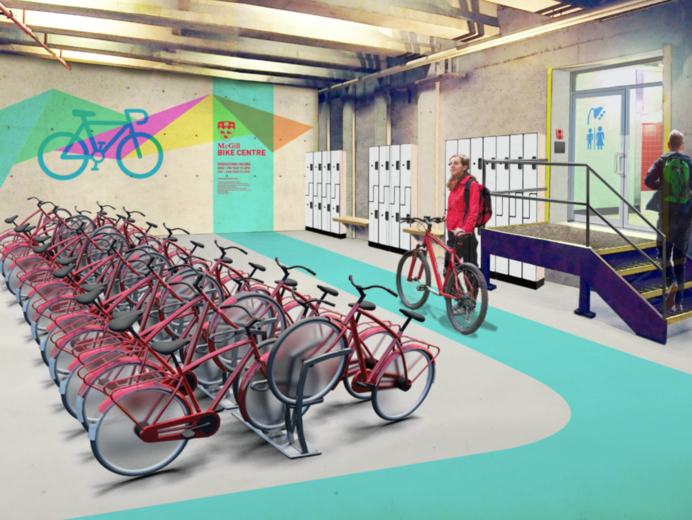For students already forced to navigate the labyrinth of construction on two wheels, the lack of bike parking on McGill’s campus is an additional grievance. The return to school was marked by the removal of two of the campus’ largest bike racks in front of the McConnell Engineering and Leacock Buildings, with no facilities added to pick up the slack. It is unacceptable that students must resort to precariously locking their bikes to the construction scaffolding outside the MacDonald-Harrington Building, or to the fence surrounding the field at the Y-intersection.
To combat the absence of bike parking, the Students’ Society of McGill University (SSMU) proposed a project that will “house secure bike parking facilities, shower, and locker facilities, and The Flat in the basement of the SSMU Building. The proposal is a step in the right direction for bike accessibility on campus; however, the project has many shortfalls, limiting its effectiveness.
The first of the problems with this project is the estimated cost. The cost is substantial—$1.2 million for bike racks and showers—but what may be even more off-putting to students is that the budget requires them to elect to pay a per semester fee to use the facility. Regardless of the eventual amount—which is not yet known—the fee will be a major turn-off for students, due to the fact that they can already park their bikes for free outside. The only foreseeable benefits of this proposed bike space would be security and protection from the weather. However, protection from the elements may be superfluous as many students won’t choose to bike to campus on days of poor conditions—essentially, any day between November and April. For a facility that will only realistically see use for a handful of months each year, $1.2 million is simply unjustifiable.
The second flaw is the distance of the SSMU Building from some important locations. SSMU is inconveniently located for students entering campus through the Roddick and Milton gates. Furthermore, it is not located near the academic buildings surrounding the Y-intersection, nor those above Dr. Penfield, such as McIntyre Medical, Stewart Biology, and the Education and Law Buildings.
Another issue with this project is the timeline. By committing to a permanent facility to be built in 2018, SSMU is providing a belated, permanent solution to a problem that needs to be addressed immediately, given the state of construction on campus. Members of the McGill community need accessible and convenient bike storage locations now.
The Motion Regarding the Bicycle Facility Plebiscite Question was included in the SSMU 2016 Winter Referendum, and in spite of its shortcomings, was ratified with 83 per cent in favour. Democracy has spoken; however, this does not mean that the practical limitations of implementing such a project should be dismissed.
A sufficient—not to mention inexpensive and feasible—solution would be to place more bicycle racks outside of all major buildings on campus, including libraries and service buildings. Decentralizing bicycle parking will allow students to save time on their commute, as well as avoid the congested existing bike racks.
The McGill administration’s collaboration with SSMU marks a significant shift in attitude towards bikes on campus. It would seem that students will win the campus cycling war, as the bike facility marks a departure from the university’s previous efforts to curtail bicycle use. Many cyclists remember being asked by campus security to dismount, and perhaps recall the bike-proof gates that were installed at the Milton Gates in 2013 to curb bicycle riding on campus. The issue of bikes has been divisive at McGill, with the McGill administration siding with pedestrians in asserting that bikes should be walked on campus—not ridden. Of course, cyclists have insisted that with proper accessibility and safety procedures in place—such as bike lanes—there is no reason to dismount.
Although the indoor bicycle parking facility is a novel solution to a genuine, on-going issue on campus, it will not effectively solve the problem. The proposal of a bike accessible space marks a progressive step towards accepting the inevitability of bicycling on campus, but the solution is neither practical nor sufficient.









